Hoists, tools and taxis - Mick's Workshop 443



|
It's time you got a hoist, but which one?
MICK'S WORKSHOP
As you know, we have a big project underway in the workshop, which is a one-off build for Tom’s HG GTS Monaro. He’s going for a big engine and a lot of custom-made components, including the rear axle you see here.
It’s been built specifically for this car by local expert Charlie Gauci, and last issue we did a trial-fit to ensure everything was sweet before the final product was assembled. It fitted like the proverbial glove and today we’ve been tackling the allegedly simple job of fitting up the rear drum brakes.
It always makes me laugh that no matter how many times you do this, or how experienced you are, every now and then life will throw something at you to keep you on your toes.
We’ve actually did an extra dummy fit, just to be doubly sure the wheel package works.
We had every brake nut and bolt cleaned and plated as a back-up for the new components we bought. All the critical pieces are new, such as wheel cylinders, springs and of course shoes.
Speaking of shoes, here’s a quick assembly tip: remember the long shoe goes to the rear and the short shoe to the front. Do it the other way around and you’ll discover a much too snatchy brake pedal when you do to drive it.
While we kept the old brake cables and they worked just fine, they were only on the shelf so we had something to match the new ones to. Really, for a mechanical build like this, you go for new parts as much as reasonably possible, as re-using old gear like the cables is just a false economy. Oh, and the new gear looks a whole lot better.
On designs like this, you’ll find the shoes rub against the backing plate in a few places. You really want a long-term lubricant in there just to keep everything working smoothly. For this job, I used just a little copper grease, which also tends to eliminate that harmonic squeal you can get.
Now for some reason, the shoes and springs put up an almighty battle when it came to final fitment. It really had me wondering if there was a mismatched component and this is another reason why you keep all the original components. Then you have something to compare the new gear to, so you can ensure mounting tabs, holes and the like are where they should be.
Plus, my next hot tip – take a photo of the assembly before you pull it apart!
In this case I was kind of second guessing myself, worrying the spring tension was too great and ended up having a couple of goes at it before I was happy.
It all worked out and, sometimes, it just pays to stop, have a cup of tea (not a beer!), enjoy the sun for a few minutes, then hop back into the job.
Here's my tip
Permit me
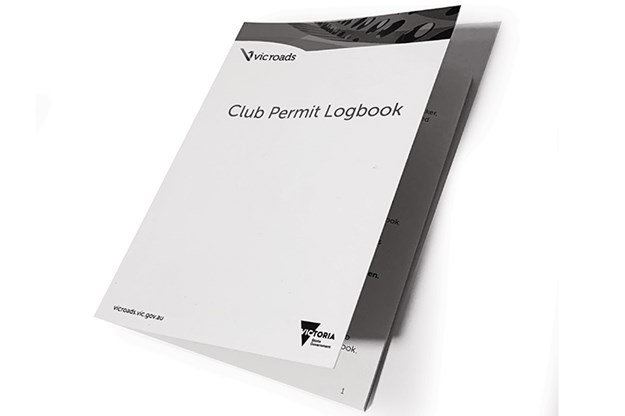
If you drive a car on a club permit, it’s all too easy to forget to sign the logbook. Stick it on the gearshift so you can’t possibly miss it when you go to move the car.
LETTERS
Hoisted Take 2
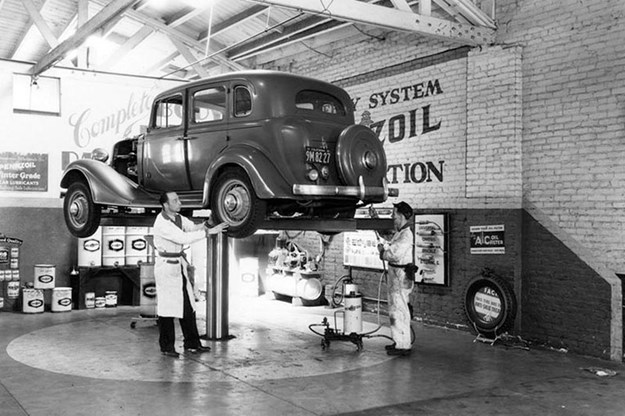
A classic single-post hoist. Looks great
Further to Les Rose’s letter (UC 442) there are several considerations associated with deciding the purchase of a vehicle hoist, as there are four basic types to choose from:
Four Post fixed,
Four Post movable,
Two post fixed.
Single post (generally movable).
In broad terms, one needs to take into account what is likely to be lifted, and where it is likely to be lifted from.
I am an octogenarian and have three heritage vehicles to service, a 1926 Chev. a 1947 Chev, and a 1975 Jaguar. I have no trouble crawling under the 26 Chev for service, the 47 is a bit of a challenge, and there is no earthly way I could get under the Jag!
The available space in my workshop is 6.0m wide, and I needed to park a 2.4m wide caravan alongside the area in which I wanted to set my hoist.
Two post and four post hoists take up about 3.7m of floor width, so this practically put them out of consideration (leaving only 2.3m width in which to park a 2.4m wide caravan) so I went for a single poster.
The single poster has a capacity of 2500kg, and copes well with both the 47 Chev and the Jag. The ability to move the hoist around the work area, even after the vehicle is over the descended hoist is most welcome. When not in use, it occupies about 2.4m of workshop width. Like a two poster, its support of the vehicle permits work on the suspension much more readily than a vehicle raised on a four poster. However it is well above the cost of a two or four poster, However, its ability to lift the 26 Chev is virtually non-existent. This is because, even with manufactured chocks, the lift arms contact the running boards and valances before they are able to contact the chassis rails. In addition, the reach of the lift arms is limited and unable to readily contact the narrow chassis rails of the old Chev.
Consequently, I strongly suggest that those wishing to service veteran, vintage, and even most post vintage vehicles put four post hoists at the top of their shopping lists, and tolerate the limited ability to work on suspensions, but those with 50s and later vehicles consider all four types before making a decision.
Barry Garment
SOME INTERESTING advice there, Barry, many thanks. You inspired us to wander down the street to a mate of mine, who has a couple of hoists installed in his house, and I reckon is a good example of a well set-up home garage.
I too recommend a four-post hoist. For the person who wants to store cars, and do the odd bit of tinkering, this is the safest option because anyone can use it.
If you get a two-post wrong, the car can tip off it. The positioning and weight distribution is critical.
I never recommend moveable ones, unless you’re dealing with a giant shed and you know what you’re doing. Really, a moveable hoist is just another weak link looking to create a problem. For home use, just bolt it to the floor.
We took a little visit down to my mate Phil’s shed (below), where he has two Tufflift four-posters in place. This is the perfect set-up for home, I reckon. They run off a normal domestic power supply – so no need for three-phase installations – seem pretty bulletproof and very simple to operate.

Phil, Mick and a well set-up pair of hoists
Something that works really well is the two can be mounted hard up against each other, so you don’t need an acreage to get them in. He did however have his garage built with a little extra height.
Phil has had these for a while. He’s had them serviced occasionally for peace of mind, but reckons they’re trouble-free and very simple to use. They’re pretty straight-forward to drive on and off.
If you have three-phase power on tap, great. You get more grunt with that set-up, which is why we tend to use them in a workshop where they’re in constant operation.
In fact, we have both in my shop. The three-phase units do the heavy work, while I have another on a normal supply that just gets used occasionally.
Alarmed

An old Ford can be alarming enough without adding aftermarket electrics
I’ve got an old XT Falcon GT and, like a lot of old Aussie cars, it’s now getting to be worth a bit of money. What do you reckon about fitting a modern car alarm? I sometimes worry about what happens at shows.
Dave Dyson
NO, NO and again no. Car alarms definitely have their place, but I’m not a fan of them in an old car. One reason is I’ve seen cars being towed away with the alarm going off – so was that stolen or just being towed by an owner who couldn’t switch it off?
The thing is you need to mess with the original car to do it, and that’s not always a happy result. Aftermarket offerings vary hugely in quality and aren’t always reliable.
It’s a whole different situation where the unit is integrated into the original design.
My preference is for good security at home – such as lockable posts in the shed – and keeping an eye on the thing when you’re at a car show.
And, if the old car is valuable to you, it makes all sorts of sense to have a daily driver that you don’t mind taking all the bumps and bruises.
Last but far from least, make sure you’re insured. People like Shannons will do pretty decent deals for multi-car owners, particularly for vehicles that spend most of their time under a cover.
Electric Nuts
Mick asked for suggestions from readers to follow after the hoist review. My suggestion would be to review battery power tools. A battery rattle gun for example would be a desirable tool but which ones are capable of undoing tight wheel nuts?
Les Rose
WOW, THERE’S months of material in that one. So I’ll get together with the photographer and we’ll start looking at some of our own gear. Okay, quality counts and I’ll take a closer look at the whole quality issue next edition.
First up though, let’s talk battery rattle guns. Now I know you see rattle guns in workshops the whole time, particularly at tyre fitting shops. However I’m not a big fan of them. They have their place, but we use them very, very sparingly in my workshop.
As an apprentice, I wasn’t allowed to use them at all!
The trick is you should use them as a labour-saving device and not as a way to move reluctant bolts. We had a bit of a chat about bolts and threads a little while ago, and while you can recover an ordinary thread, force never solved an issue with them.
So, if I’m concerned about a thread during assembly, I stop and fix it. Anything that’s damaged is only going to get worse.
If I have something that doesn’t want to undo, then a rattle gun is the last thing to use. You might try penetrating fluid, and leave it overnight. In extreme cases you might need to use heat, and or a bit of a tap to shock something loose. In that case, expect some repair work once you have everything undone. The whole time, we’re using manual tools to get it undone, because I want to feel what’s going on.
So, rattle gun? Just fine when you’re dealing with good threads and using it as a labour-saving device. It’s a beautiful tool, but here’s a tip: if it sounds like it’s working hard, stop. Something is wrong.
How much for a Z3?
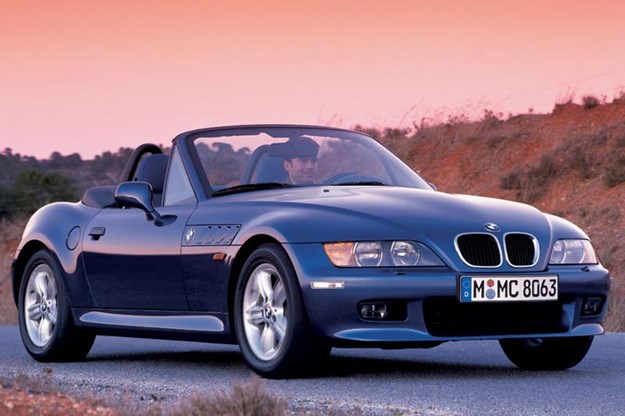
Hello there, I am a regular subscriber and contributor and have been offered a BMW Z3. Have you a guideline about how much I should pay...please?
Michael Pyper
A LOT depends on spec and mileage. For example, a high-mile 1.9lt auto is probably worth no more than about 8k.
However an exceptional low mileage (under 100,000km) 1.9lt manual could fetch as much as 15k.
You’ll find a similar range with the 2.9lt sixes: as little as 10k for a high miler in average condition, up to mid-twenties for a very good low-mile manual.
Here’s a tip, the six-cylinder versions are far superior and worth the extra money. Great motors. Also, those engines must be run with the correct oil if you want them to last. And it needs to be changed on time. Use the wrong oil and you can seize the buckets, which means throwing away the head.
Let us know how you get on.
Benz Bruiser
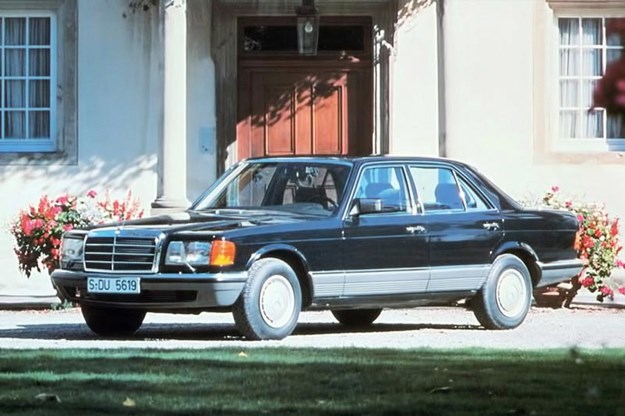
I read in an issue or two ago about the Merc SELs. Well, I have got a couple and I think I wrote to you about the 1980 380 SEL.
Well, I put a 420 in it and my grandma’s old splitty pulls harder, so I want you to ask your cast of thousands and your learned readers to tell me what I can successfully put in it that will make it go hard.
Can I soup up my 420, maybe supercharge it? I’ve seen a few highly modified jobs that are not street legal at burnout comps but no I’ve got to be sensible and keep it street legal.
I think the sump is the problem so Chev is out. Maybe a Ford?
And who makes the conversion kits? Anyway, you get my drift.
I’m on a drip of bourbon and three packs of valium a day worrying about what to do.
I’ve had to put up a tall fence to hide my Mercs as they are a wanted item now.
All the best to you and your colleagues – stay sober bloke and get back to work!
Robert Bawden
Downtown virus-free sunny Ravensthorpe
GEE, A bit to chew on there, Robert. Yep you did read something about big Benzes recently, as Ed Guido recently bought a W126 300SEL. I’ve worked on that car and they’re a good thing.
The picture with most of the Benz engines of that era is they were designed to be big relatively lazy cruisers, rather than tyre-burning monsters. The engines last, but they’re not going to set the world on fire.
You could have a crack at souping up the 420, but if it were me I’d save the money. Really, you’ll spend a bomb for not enough gain.
A lot of people have put LS engines into all sorts of Benz variants of that era, including coupes and sedans, and that’s probably the way to go. An LS (there are several generations available) are generally compact and deliver decent bang for the buck. Plus there is a lot of tuning knowledge out there for them.
I’m not sure you’ll find a kit for them, but there are lots of clever people locally who might be able to help. Funnily enough, I’d also put aside some time to trawl through modifier sites in Norway and Sweden. Yep, I know that sounds weird, but there’s some pretty wild stuff going on in that part of the world and you just might get some inspiration.
Taxi!
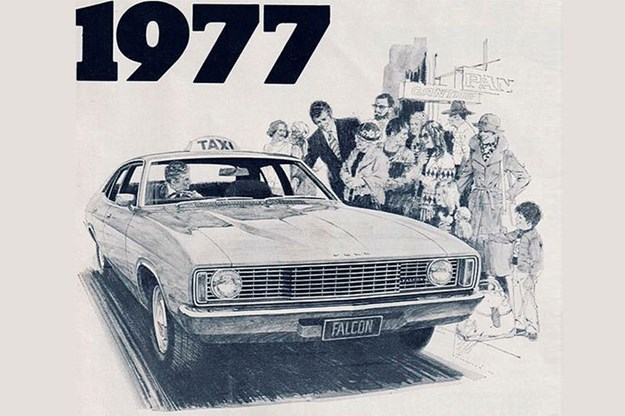
Our Facebook feed recently fired up a storm when we ran with an old Ford ad promoting the 1977 Falcon taxi pack as the country’s top-seller.
Rob Johnson commented: "Without a doubt, the superior durability of Falcon and it being the best choice for taxis was a double-edged sword for Ford. As a salesperson, I lost count of the times a customer chose not to buy a Falcon because it felt like a taxi!"
Gabriel Leggieri added: "Ford even had consultant for the taxi industry. His sole role was to attend to the issues that would arise in taxis around Australia. Many click over one million kms."
Which begs the question, would you buy and restore an ex-taxi? A few people have done it and you’d have to wonder how tired a million kilometer car would be. Okay, who out there has a taxi resto underway, or is using an ex-taxi as a daily driver?
Shoot us a pic and let us know how you’re getting on!
Trivial Pursuit
French for taxi
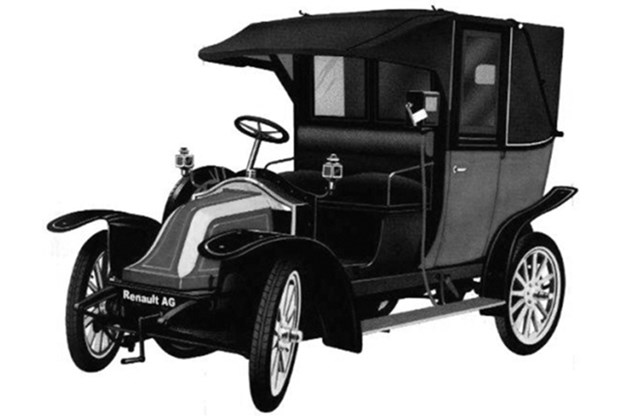
Motorised taxis came into service in Sydney around 1906, and other capitals soon followed. Renault tended to dominate the market in these early years.
Write to Mick c/o uniquecars@primecreative.com.au or Unique Cars magazine, 379 Docklands Drive, Docklands, Victoria 3008
From Unique Cars #443, August 2020
Unique Cars magazine Value Guides
Sell your car for free right here
Get your monthly fix of news, reviews and stories on the greatest cars and minds in the automotive world.
Subscribe

.jpg)








